Regional Gardens Ltd: Cloud Migration & Microservices Strategy
VerifiedAdded on 2023/06/11
|26
|7544
|430
Report
AI Summary
This report analyzes the strategic proposal for Regional Gardens Ltd to migrate its web services to a hybrid cloud environment, adopting a microservices model to enhance flexibility and scalability. It discusses the selection of cloud architectures, specifically recommending Platform as a Service (PaaS), and outlines the benefits and issues associated with its deployment. The report also addresses the risks related to hybrid cloud and microservices strategies, including lack of disaster recovery planning and security vulnerabilities, and proposes relevant controls. Furthermore, it covers information security steps, business continuity planning, remote server administration, resource management, SLA management, and the migration of email instances to Amazon Web Services, highlighting critical points and potential issues. The document provides a comprehensive overview of the considerations and strategies involved in transitioning to a hybrid cloud and microservices architecture for Regional Gardens Ltd, offering valuable insights into cloud computing and its practical applications. Desklib provides similar solved assignments for students.
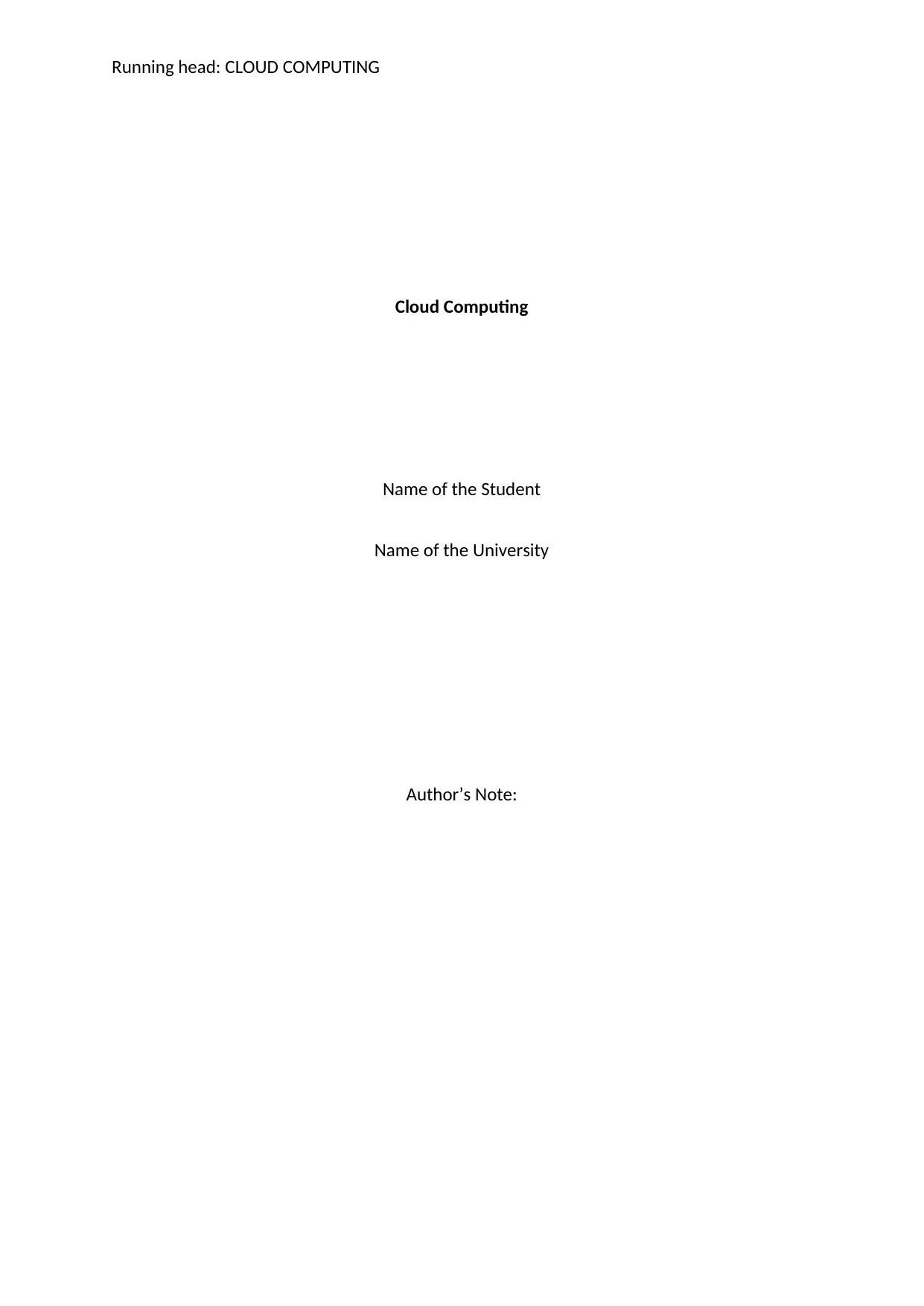
Running head: CLOUD COMPUTING
Cloud Computing
Name of the Student
Name of the University
Author’s Note:
Cloud Computing
Name of the Student
Name of the University
Author’s Note:
Paraphrase This Document
Need a fresh take? Get an instant paraphrase of this document with our AI Paraphraser

1
CLOUD COMPUTING
Table of Contents
Introduction...............................................................................................................................2
Discussion...................................................................................................................................3
1. Selection of Cloud Architectures for a Hybrid Cloud.........................................................3
1.1. Description of the Selected Cloud Architectures and the Reasons for this
Deployment........................................................................................................................5
1.2. Benefits and Issues for the Deployment of the Selected Cloud Architectures...........6
2. Risks Associated with Hybrid Cloud and Micro Services Strategy and their Controls.......8
3. Information Security Steps and Controls for Securing Hybrid Cloud...............................12
4. Business Continuity Planning for Hybrid Cloud and Micro services Approach................13
5. Remote Server Administration, Resource Management and SLA Management............16
6. Migration of email instances to the Amazon Web Services Cloud..................................17
6.1. Various Steps for Migrating the Organizational Services.........................................17
6.2. Critical Point as well as Issues for the Steps with Proper Explanation.....................18
Conclusion................................................................................................................................19
References................................................................................................................................21
CLOUD COMPUTING
Table of Contents
Introduction...............................................................................................................................2
Discussion...................................................................................................................................3
1. Selection of Cloud Architectures for a Hybrid Cloud.........................................................3
1.1. Description of the Selected Cloud Architectures and the Reasons for this
Deployment........................................................................................................................5
1.2. Benefits and Issues for the Deployment of the Selected Cloud Architectures...........6
2. Risks Associated with Hybrid Cloud and Micro Services Strategy and their Controls.......8
3. Information Security Steps and Controls for Securing Hybrid Cloud...............................12
4. Business Continuity Planning for Hybrid Cloud and Micro services Approach................13
5. Remote Server Administration, Resource Management and SLA Management............16
6. Migration of email instances to the Amazon Web Services Cloud..................................17
6.1. Various Steps for Migrating the Organizational Services.........................................17
6.2. Critical Point as well as Issues for the Steps with Proper Explanation.....................18
Conclusion................................................................................................................................19
References................................................................................................................................21
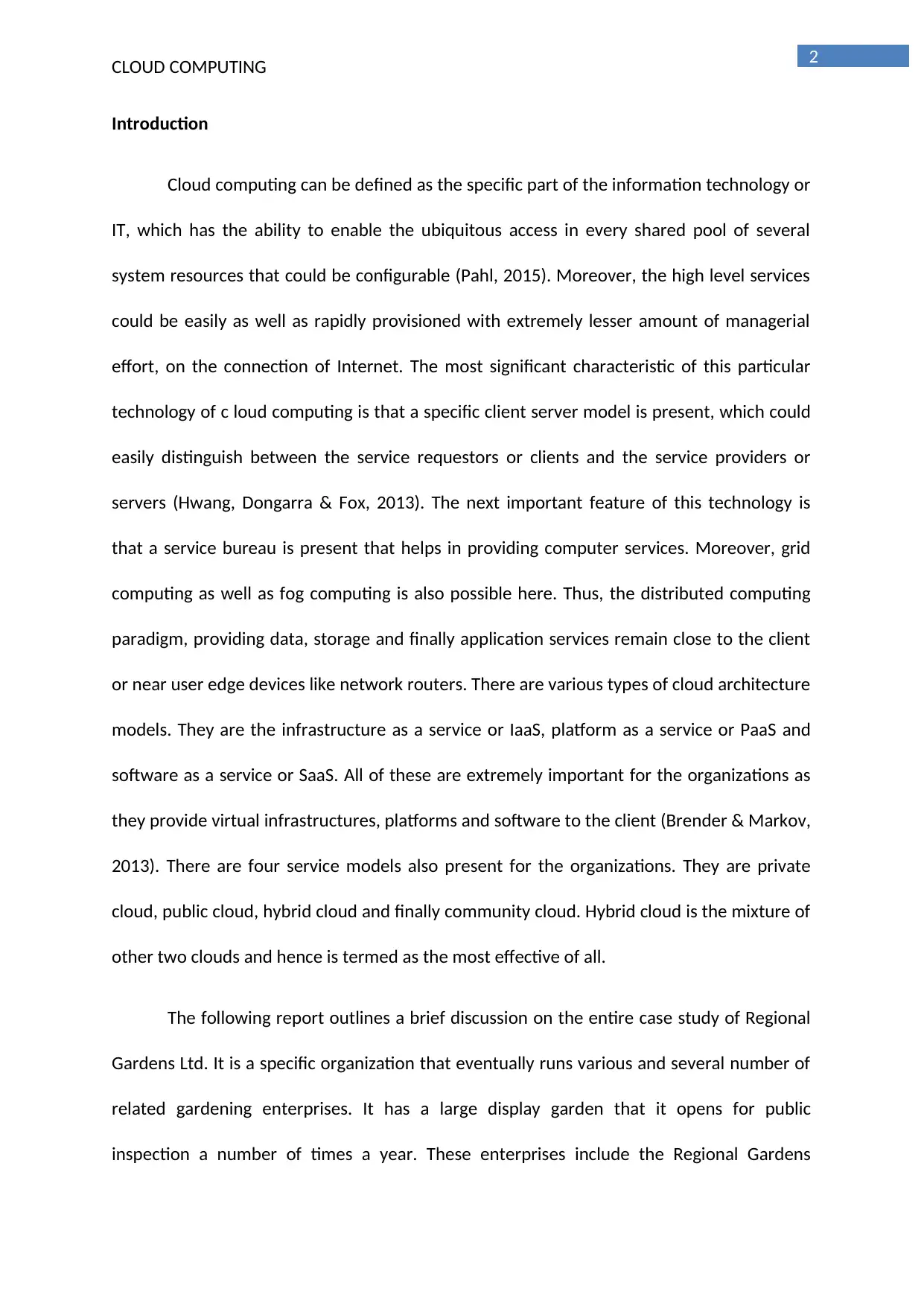
2
CLOUD COMPUTING
Introduction
Cloud computing can be defined as the specific part of the information technology or
IT, which has the ability to enable the ubiquitous access in every shared pool of several
system resources that could be configurable (Pahl, 2015). Moreover, the high level services
could be easily as well as rapidly provisioned with extremely lesser amount of managerial
effort, on the connection of Internet. The most significant characteristic of this particular
technology of c loud computing is that a specific client server model is present, which could
easily distinguish between the service requestors or clients and the service providers or
servers (Hwang, Dongarra & Fox, 2013). The next important feature of this technology is
that a service bureau is present that helps in providing computer services. Moreover, grid
computing as well as fog computing is also possible here. Thus, the distributed computing
paradigm, providing data, storage and finally application services remain close to the client
or near user edge devices like network routers. There are various types of cloud architecture
models. They are the infrastructure as a service or IaaS, platform as a service or PaaS and
software as a service or SaaS. All of these are extremely important for the organizations as
they provide virtual infrastructures, platforms and software to the client (Brender & Markov,
2013). There are four service models also present for the organizations. They are private
cloud, public cloud, hybrid cloud and finally community cloud. Hybrid cloud is the mixture of
other two clouds and hence is termed as the most effective of all.
The following report outlines a brief discussion on the entire case study of Regional
Gardens Ltd. It is a specific organization that eventually runs various and several number of
related gardening enterprises. It has a large display garden that it opens for public
inspection a number of times a year. These enterprises include the Regional Gardens
CLOUD COMPUTING
Introduction
Cloud computing can be defined as the specific part of the information technology or
IT, which has the ability to enable the ubiquitous access in every shared pool of several
system resources that could be configurable (Pahl, 2015). Moreover, the high level services
could be easily as well as rapidly provisioned with extremely lesser amount of managerial
effort, on the connection of Internet. The most significant characteristic of this particular
technology of c loud computing is that a specific client server model is present, which could
easily distinguish between the service requestors or clients and the service providers or
servers (Hwang, Dongarra & Fox, 2013). The next important feature of this technology is
that a service bureau is present that helps in providing computer services. Moreover, grid
computing as well as fog computing is also possible here. Thus, the distributed computing
paradigm, providing data, storage and finally application services remain close to the client
or near user edge devices like network routers. There are various types of cloud architecture
models. They are the infrastructure as a service or IaaS, platform as a service or PaaS and
software as a service or SaaS. All of these are extremely important for the organizations as
they provide virtual infrastructures, platforms and software to the client (Brender & Markov,
2013). There are four service models also present for the organizations. They are private
cloud, public cloud, hybrid cloud and finally community cloud. Hybrid cloud is the mixture of
other two clouds and hence is termed as the most effective of all.
The following report outlines a brief discussion on the entire case study of Regional
Gardens Ltd. It is a specific organization that eventually runs various and several number of
related gardening enterprises. It has a large display garden that it opens for public
inspection a number of times a year. These enterprises include the Regional Gardens
⊘ This is a preview!⊘
Do you want full access?
Subscribe today to unlock all pages.

Trusted by 1+ million students worldwide
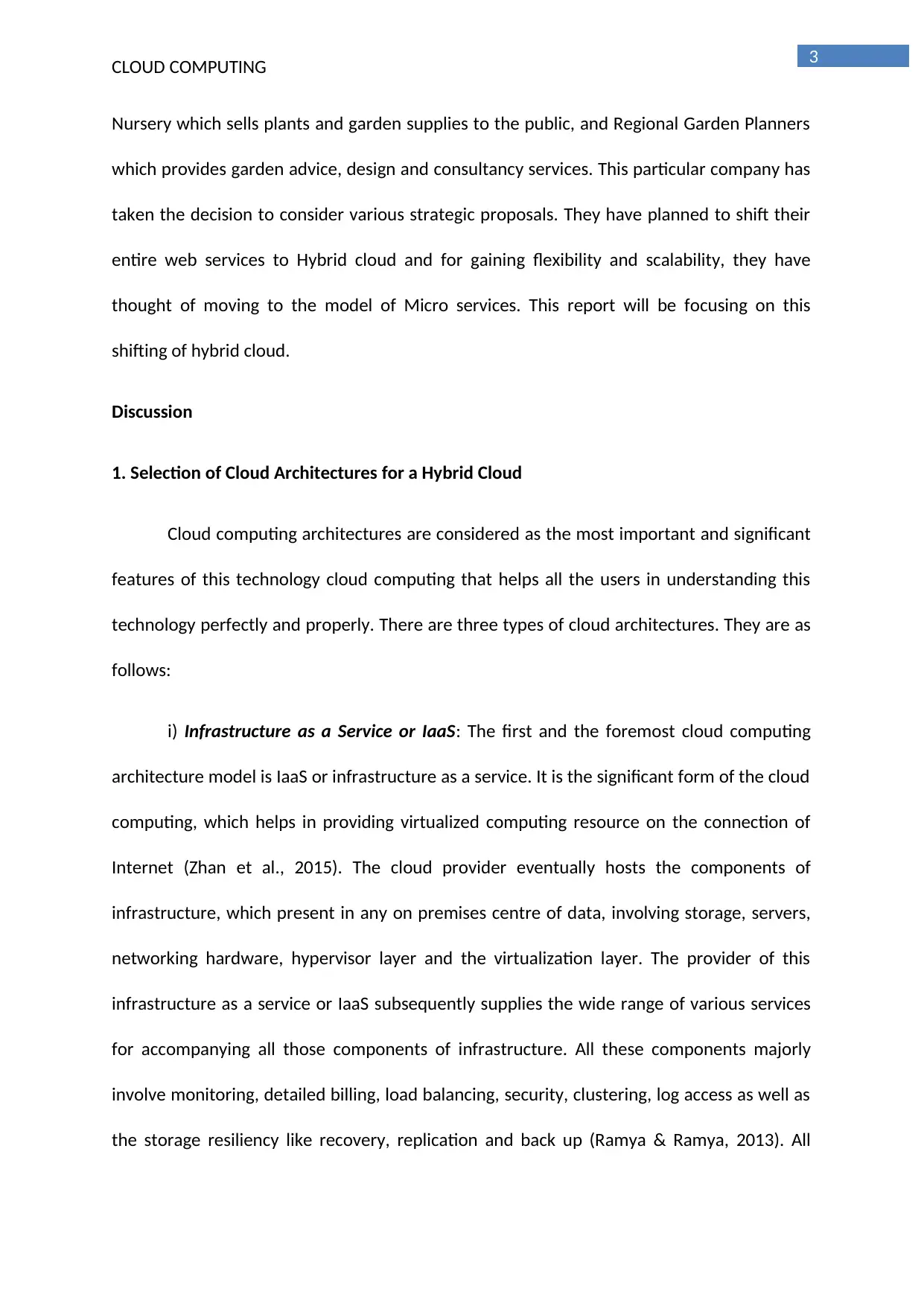
3
CLOUD COMPUTING
Nursery which sells plants and garden supplies to the public, and Regional Garden Planners
which provides garden advice, design and consultancy services. This particular company has
taken the decision to consider various strategic proposals. They have planned to shift their
entire web services to Hybrid cloud and for gaining flexibility and scalability, they have
thought of moving to the model of Micro services. This report will be focusing on this
shifting of hybrid cloud.
Discussion
1. Selection of Cloud Architectures for a Hybrid Cloud
Cloud computing architectures are considered as the most important and significant
features of this technology cloud computing that helps all the users in understanding this
technology perfectly and properly. There are three types of cloud architectures. They are as
follows:
i) Infrastructure as a Service or IaaS: The first and the foremost cloud computing
architecture model is IaaS or infrastructure as a service. It is the significant form of the cloud
computing, which helps in providing virtualized computing resource on the connection of
Internet (Zhan et al., 2015). The cloud provider eventually hosts the components of
infrastructure, which present in any on premises centre of data, involving storage, servers,
networking hardware, hypervisor layer and the virtualization layer. The provider of this
infrastructure as a service or IaaS subsequently supplies the wide range of various services
for accompanying all those components of infrastructure. All these components majorly
involve monitoring, detailed billing, load balancing, security, clustering, log access as well as
the storage resiliency like recovery, replication and back up (Ramya & Ramya, 2013). All
CLOUD COMPUTING
Nursery which sells plants and garden supplies to the public, and Regional Garden Planners
which provides garden advice, design and consultancy services. This particular company has
taken the decision to consider various strategic proposals. They have planned to shift their
entire web services to Hybrid cloud and for gaining flexibility and scalability, they have
thought of moving to the model of Micro services. This report will be focusing on this
shifting of hybrid cloud.
Discussion
1. Selection of Cloud Architectures for a Hybrid Cloud
Cloud computing architectures are considered as the most important and significant
features of this technology cloud computing that helps all the users in understanding this
technology perfectly and properly. There are three types of cloud architectures. They are as
follows:
i) Infrastructure as a Service or IaaS: The first and the foremost cloud computing
architecture model is IaaS or infrastructure as a service. It is the significant form of the cloud
computing, which helps in providing virtualized computing resource on the connection of
Internet (Zhan et al., 2015). The cloud provider eventually hosts the components of
infrastructure, which present in any on premises centre of data, involving storage, servers,
networking hardware, hypervisor layer and the virtualization layer. The provider of this
infrastructure as a service or IaaS subsequently supplies the wide range of various services
for accompanying all those components of infrastructure. All these components majorly
involve monitoring, detailed billing, load balancing, security, clustering, log access as well as
the storage resiliency like recovery, replication and back up (Ramya & Ramya, 2013). All
Paraphrase This Document
Need a fresh take? Get an instant paraphrase of this document with our AI Paraphraser

4
CLOUD COMPUTING
these services are increasingly driven by policy, which helps to enable all the users of this
infrastructure as a service in properly implementing the greater level for automation as well
as orchestration.
ii) Platform as a Service or PaaS: The second cloud architecture model after the
infrastructure as a service is the PaaS or platform as a service. Platform as a service is the
particular model of cloud computing, where the third party provider delivers all the tools
and technologies of hardware as well as software (Bora & Ahmed, 2013). All these are
required for developing the applications to their clients with the connectivity of Internet.
The provider of this platform as a service significantly hosts the software as well as
hardware over its own infrastructure. Thus, the platform as a service helps in freeing the
users from getting installed the in house hardware or software for either developing or
running the new application. The main feature of this platform as a service is that it never
replaces the complete infrastructure of the information technology and instead it relies on
the providers of the platform as a service like development of Java and application hosting
(Al-Roomi et al., 2013). The building as the supplying of the resilient as well as the optimized
environment by the provider of a platform as a service, over which the clients could easily
install the sets of data and applications are done easily. All these features help the users in
acquiring the cloud architecture model under any circumstances.
iii) Software as a Service or SaaS: Software as a service of SaaS is the third most
important cloud architecture model or software distribution model, where the third party
provider eventually hosts every application in making them completely available to the
customers on the Internet. The software as a service eradicates the need for the companies
in installing as well as running the applications over their own computers or over their own
CLOUD COMPUTING
these services are increasingly driven by policy, which helps to enable all the users of this
infrastructure as a service in properly implementing the greater level for automation as well
as orchestration.
ii) Platform as a Service or PaaS: The second cloud architecture model after the
infrastructure as a service is the PaaS or platform as a service. Platform as a service is the
particular model of cloud computing, where the third party provider delivers all the tools
and technologies of hardware as well as software (Bora & Ahmed, 2013). All these are
required for developing the applications to their clients with the connectivity of Internet.
The provider of this platform as a service significantly hosts the software as well as
hardware over its own infrastructure. Thus, the platform as a service helps in freeing the
users from getting installed the in house hardware or software for either developing or
running the new application. The main feature of this platform as a service is that it never
replaces the complete infrastructure of the information technology and instead it relies on
the providers of the platform as a service like development of Java and application hosting
(Al-Roomi et al., 2013). The building as the supplying of the resilient as well as the optimized
environment by the provider of a platform as a service, over which the clients could easily
install the sets of data and applications are done easily. All these features help the users in
acquiring the cloud architecture model under any circumstances.
iii) Software as a Service or SaaS: Software as a service of SaaS is the third most
important cloud architecture model or software distribution model, where the third party
provider eventually hosts every application in making them completely available to the
customers on the Internet. The software as a service eradicates the need for the companies
in installing as well as running the applications over their own computers or over their own
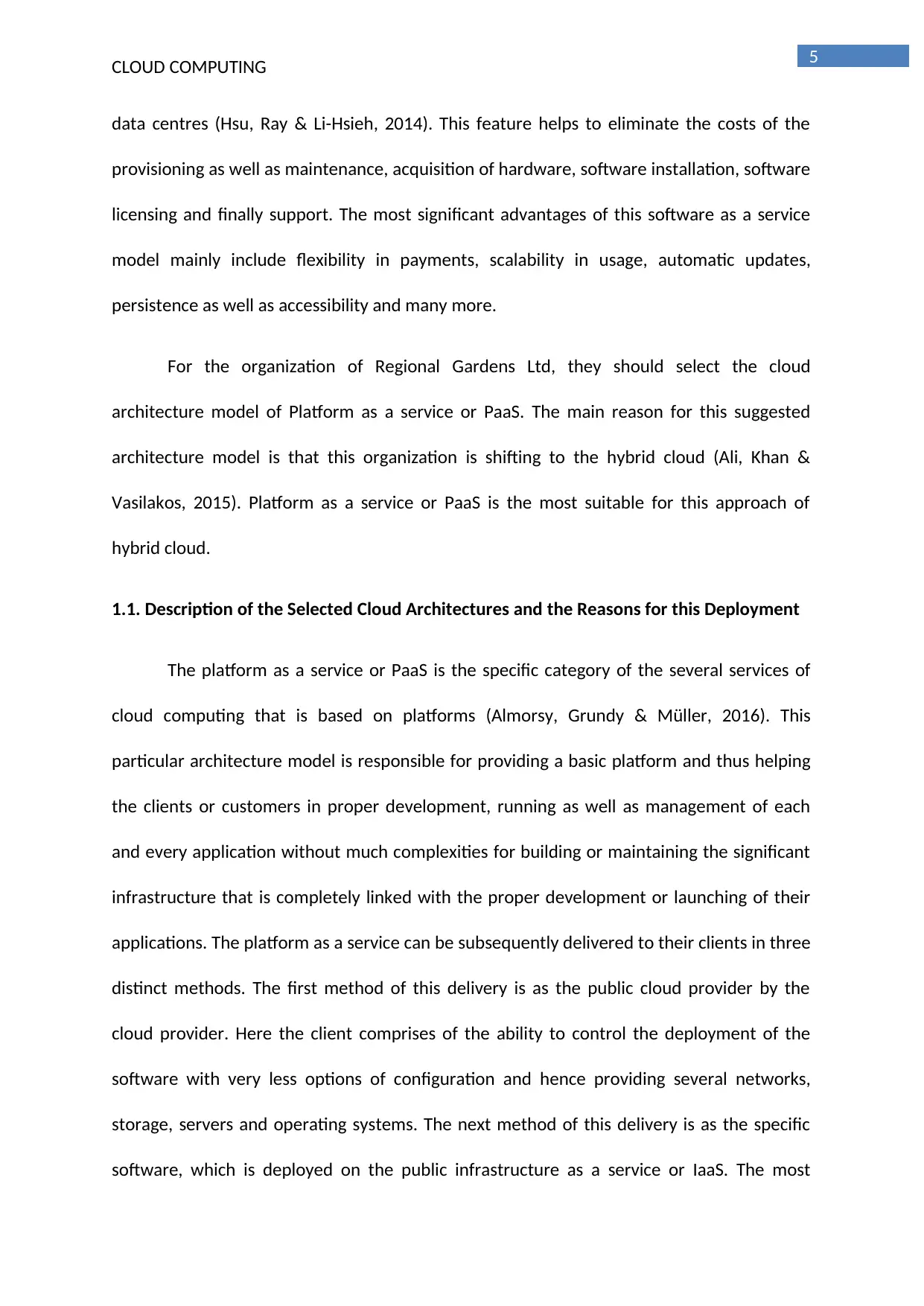
5
CLOUD COMPUTING
data centres (Hsu, Ray & Li-Hsieh, 2014). This feature helps to eliminate the costs of the
provisioning as well as maintenance, acquisition of hardware, software installation, software
licensing and finally support. The most significant advantages of this software as a service
model mainly include flexibility in payments, scalability in usage, automatic updates,
persistence as well as accessibility and many more.
For the organization of Regional Gardens Ltd, they should select the cloud
architecture model of Platform as a service or PaaS. The main reason for this suggested
architecture model is that this organization is shifting to the hybrid cloud (Ali, Khan &
Vasilakos, 2015). Platform as a service or PaaS is the most suitable for this approach of
hybrid cloud.
1.1. Description of the Selected Cloud Architectures and the Reasons for this Deployment
The platform as a service or PaaS is the specific category of the several services of
cloud computing that is based on platforms (Almorsy, Grundy & Müller, 2016). This
particular architecture model is responsible for providing a basic platform and thus helping
the clients or customers in proper development, running as well as management of each
and every application without much complexities for building or maintaining the significant
infrastructure that is completely linked with the proper development or launching of their
applications. The platform as a service can be subsequently delivered to their clients in three
distinct methods. The first method of this delivery is as the public cloud provider by the
cloud provider. Here the client comprises of the ability to control the deployment of the
software with very less options of configuration and hence providing several networks,
storage, servers and operating systems. The next method of this delivery is as the specific
software, which is deployed on the public infrastructure as a service or IaaS. The most
CLOUD COMPUTING
data centres (Hsu, Ray & Li-Hsieh, 2014). This feature helps to eliminate the costs of the
provisioning as well as maintenance, acquisition of hardware, software installation, software
licensing and finally support. The most significant advantages of this software as a service
model mainly include flexibility in payments, scalability in usage, automatic updates,
persistence as well as accessibility and many more.
For the organization of Regional Gardens Ltd, they should select the cloud
architecture model of Platform as a service or PaaS. The main reason for this suggested
architecture model is that this organization is shifting to the hybrid cloud (Ali, Khan &
Vasilakos, 2015). Platform as a service or PaaS is the most suitable for this approach of
hybrid cloud.
1.1. Description of the Selected Cloud Architectures and the Reasons for this Deployment
The platform as a service or PaaS is the specific category of the several services of
cloud computing that is based on platforms (Almorsy, Grundy & Müller, 2016). This
particular architecture model is responsible for providing a basic platform and thus helping
the clients or customers in proper development, running as well as management of each
and every application without much complexities for building or maintaining the significant
infrastructure that is completely linked with the proper development or launching of their
applications. The platform as a service can be subsequently delivered to their clients in three
distinct methods. The first method of this delivery is as the public cloud provider by the
cloud provider. Here the client comprises of the ability to control the deployment of the
software with very less options of configuration and hence providing several networks,
storage, servers and operating systems. The next method of this delivery is as the specific
software, which is deployed on the public infrastructure as a service or IaaS. The most
⊘ This is a preview!⊘
Do you want full access?
Subscribe today to unlock all pages.

Trusted by 1+ million students worldwide

6
CLOUD COMPUTING
significant reason to propose this platform as a service or PaaS for the organization of
Regional Gardens Ltd is that this can be simply incorporated within their hybrid cloud
approach (Hashem et al., 2015). The most popular and significant example of this platform
as a service or PaaS for the organization of Regional Gardens Ltd is the Amazon Web
Services or AWS. Thus, Regional Gardens Ltd should implement the cloud architecture of
PaaS.
1.2. Benefits and Issues for the Deployment of the Selected Cloud Architectures
Platform as a service or PaaS comprises of various significant benefits and issues if it
is deployed in the company of Regional Gardens Ltd. The most vital and important
advantages for the selection of the cloud architecture of PaaS are given below:
i) High Speed: The first and the foremost benefit of the deployment of the PaaS or
platform as a service is that the speed of this architecture model is much higher than the
rest of the architecture models (Hashizume et al., 2013). Each and every application of this
architecture model will function perfectly like offerings of their services. The entire hybrid
platform as a service eventually makes the process of deployment of various applications
much simpler. Moreover, the PaaS or platform as a service properly checks the management
as well as the scaling of the application deployment. The productivity of the developer solely
depends or increases by this procedure.
ii) Integration of Application Management: The next significant advantage of the
hybrid platform as a service is that it helps in the perfect integration of the application
management (Gupta, Seetharaman & Raj, 2013). The application management should be
streamlined or integrated properly for any specific hybrid cloud and this is only possible if
CLOUD COMPUTING
significant reason to propose this platform as a service or PaaS for the organization of
Regional Gardens Ltd is that this can be simply incorporated within their hybrid cloud
approach (Hashem et al., 2015). The most popular and significant example of this platform
as a service or PaaS for the organization of Regional Gardens Ltd is the Amazon Web
Services or AWS. Thus, Regional Gardens Ltd should implement the cloud architecture of
PaaS.
1.2. Benefits and Issues for the Deployment of the Selected Cloud Architectures
Platform as a service or PaaS comprises of various significant benefits and issues if it
is deployed in the company of Regional Gardens Ltd. The most vital and important
advantages for the selection of the cloud architecture of PaaS are given below:
i) High Speed: The first and the foremost benefit of the deployment of the PaaS or
platform as a service is that the speed of this architecture model is much higher than the
rest of the architecture models (Hashizume et al., 2013). Each and every application of this
architecture model will function perfectly like offerings of their services. The entire hybrid
platform as a service eventually makes the process of deployment of various applications
much simpler. Moreover, the PaaS or platform as a service properly checks the management
as well as the scaling of the application deployment. The productivity of the developer solely
depends or increases by this procedure.
ii) Integration of Application Management: The next significant advantage of the
hybrid platform as a service is that it helps in the perfect integration of the application
management (Gupta, Seetharaman & Raj, 2013). The application management should be
streamlined or integrated properly for any specific hybrid cloud and this is only possible if
Paraphrase This Document
Need a fresh take? Get an instant paraphrase of this document with our AI Paraphraser
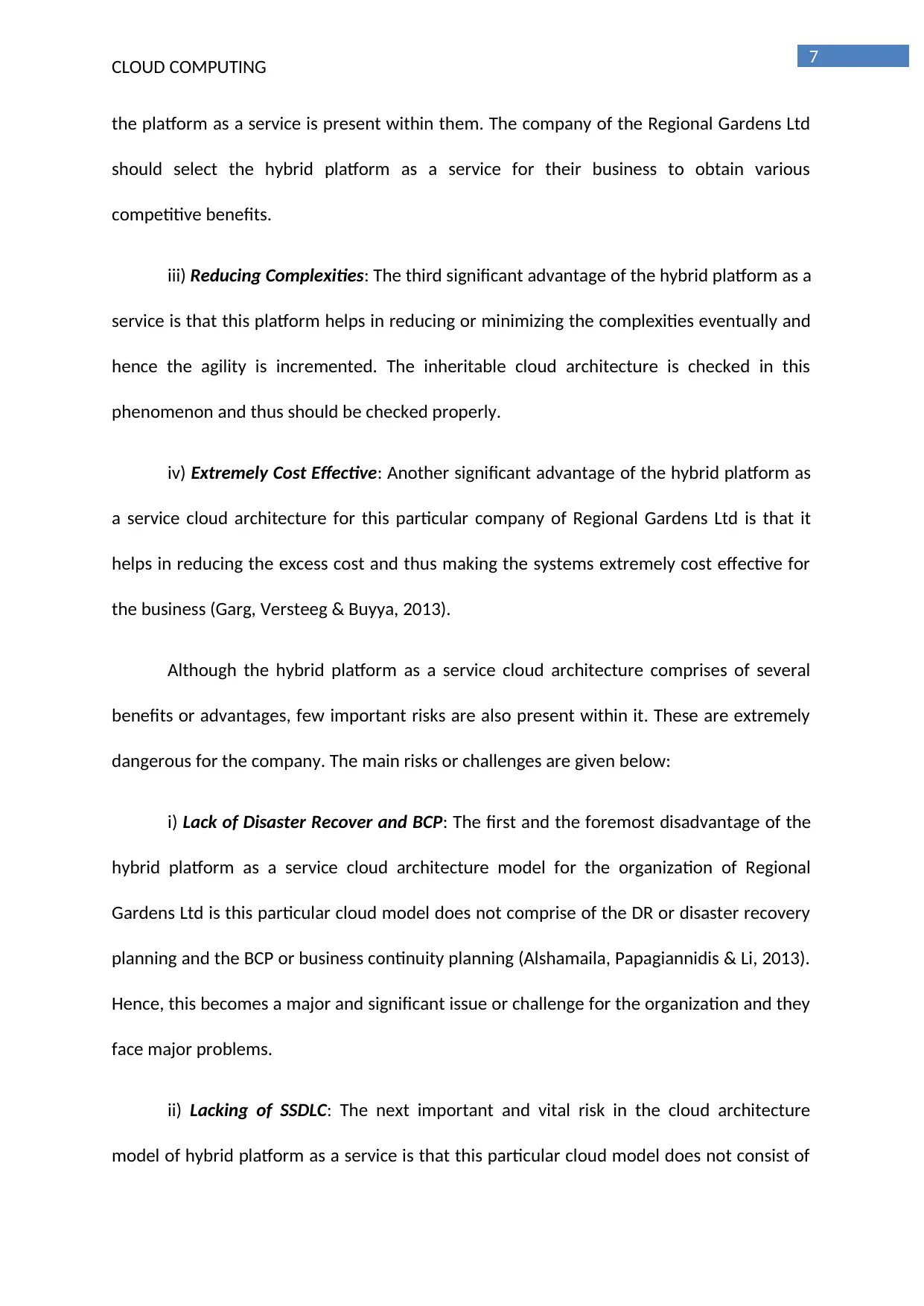
7
CLOUD COMPUTING
the platform as a service is present within them. The company of the Regional Gardens Ltd
should select the hybrid platform as a service for their business to obtain various
competitive benefits.
iii) Reducing Complexities: The third significant advantage of the hybrid platform as a
service is that this platform helps in reducing or minimizing the complexities eventually and
hence the agility is incremented. The inheritable cloud architecture is checked in this
phenomenon and thus should be checked properly.
iv) Extremely Cost Effective: Another significant advantage of the hybrid platform as
a service cloud architecture for this particular company of Regional Gardens Ltd is that it
helps in reducing the excess cost and thus making the systems extremely cost effective for
the business (Garg, Versteeg & Buyya, 2013).
Although the hybrid platform as a service cloud architecture comprises of several
benefits or advantages, few important risks are also present within it. These are extremely
dangerous for the company. The main risks or challenges are given below:
i) Lack of Disaster Recover and BCP: The first and the foremost disadvantage of the
hybrid platform as a service cloud architecture model for the organization of Regional
Gardens Ltd is this particular cloud model does not comprise of the DR or disaster recovery
planning and the BCP or business continuity planning (Alshamaila, Papagiannidis & Li, 2013).
Hence, this becomes a major and significant issue or challenge for the organization and they
face major problems.
ii) Lacking of SSDLC: The next important and vital risk in the cloud architecture
model of hybrid platform as a service is that this particular cloud model does not consist of
CLOUD COMPUTING
the platform as a service is present within them. The company of the Regional Gardens Ltd
should select the hybrid platform as a service for their business to obtain various
competitive benefits.
iii) Reducing Complexities: The third significant advantage of the hybrid platform as a
service is that this platform helps in reducing or minimizing the complexities eventually and
hence the agility is incremented. The inheritable cloud architecture is checked in this
phenomenon and thus should be checked properly.
iv) Extremely Cost Effective: Another significant advantage of the hybrid platform as
a service cloud architecture for this particular company of Regional Gardens Ltd is that it
helps in reducing the excess cost and thus making the systems extremely cost effective for
the business (Garg, Versteeg & Buyya, 2013).
Although the hybrid platform as a service cloud architecture comprises of several
benefits or advantages, few important risks are also present within it. These are extremely
dangerous for the company. The main risks or challenges are given below:
i) Lack of Disaster Recover and BCP: The first and the foremost disadvantage of the
hybrid platform as a service cloud architecture model for the organization of Regional
Gardens Ltd is this particular cloud model does not comprise of the DR or disaster recovery
planning and the BCP or business continuity planning (Alshamaila, Papagiannidis & Li, 2013).
Hence, this becomes a major and significant issue or challenge for the organization and they
face major problems.
ii) Lacking of SSDLC: The next important and vital risk in the cloud architecture
model of hybrid platform as a service is that this particular cloud model does not consist of
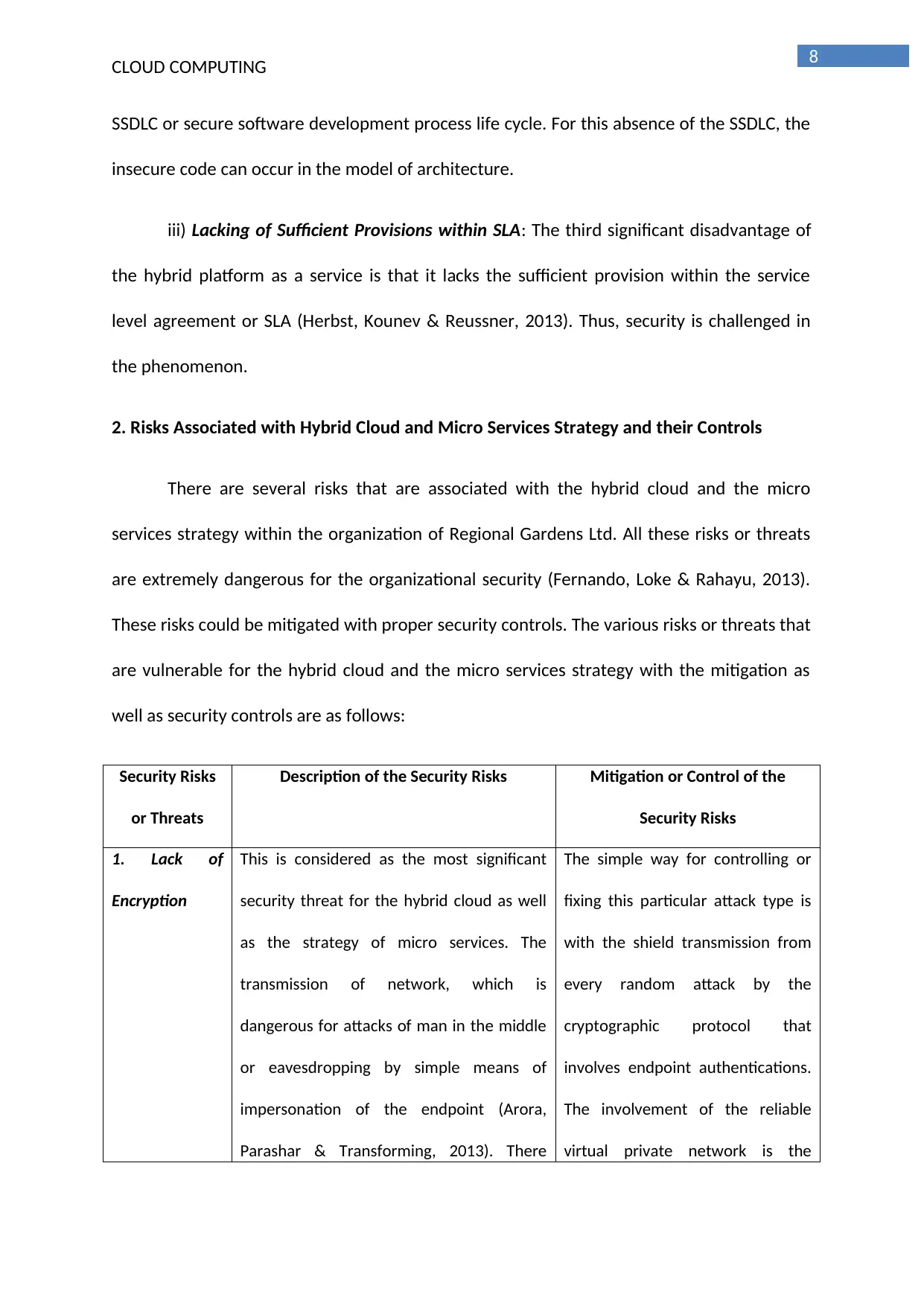
8
CLOUD COMPUTING
SSDLC or secure software development process life cycle. For this absence of the SSDLC, the
insecure code can occur in the model of architecture.
iii) Lacking of Sufficient Provisions within SLA: The third significant disadvantage of
the hybrid platform as a service is that it lacks the sufficient provision within the service
level agreement or SLA (Herbst, Kounev & Reussner, 2013). Thus, security is challenged in
the phenomenon.
2. Risks Associated with Hybrid Cloud and Micro Services Strategy and their Controls
There are several risks that are associated with the hybrid cloud and the micro
services strategy within the organization of Regional Gardens Ltd. All these risks or threats
are extremely dangerous for the organizational security (Fernando, Loke & Rahayu, 2013).
These risks could be mitigated with proper security controls. The various risks or threats that
are vulnerable for the hybrid cloud and the micro services strategy with the mitigation as
well as security controls are as follows:
Security Risks
or Threats
Description of the Security Risks Mitigation or Control of the
Security Risks
1. Lack of
Encryption
This is considered as the most significant
security threat for the hybrid cloud as well
as the strategy of micro services. The
transmission of network, which is
dangerous for attacks of man in the middle
or eavesdropping by simple means of
impersonation of the endpoint (Arora,
Parashar & Transforming, 2013). There
The simple way for controlling or
fixing this particular attack type is
with the shield transmission from
every random attack by the
cryptographic protocol that
involves endpoint authentications.
The involvement of the reliable
virtual private network is the
CLOUD COMPUTING
SSDLC or secure software development process life cycle. For this absence of the SSDLC, the
insecure code can occur in the model of architecture.
iii) Lacking of Sufficient Provisions within SLA: The third significant disadvantage of
the hybrid platform as a service is that it lacks the sufficient provision within the service
level agreement or SLA (Herbst, Kounev & Reussner, 2013). Thus, security is challenged in
the phenomenon.
2. Risks Associated with Hybrid Cloud and Micro Services Strategy and their Controls
There are several risks that are associated with the hybrid cloud and the micro
services strategy within the organization of Regional Gardens Ltd. All these risks or threats
are extremely dangerous for the organizational security (Fernando, Loke & Rahayu, 2013).
These risks could be mitigated with proper security controls. The various risks or threats that
are vulnerable for the hybrid cloud and the micro services strategy with the mitigation as
well as security controls are as follows:
Security Risks
or Threats
Description of the Security Risks Mitigation or Control of the
Security Risks
1. Lack of
Encryption
This is considered as the most significant
security threat for the hybrid cloud as well
as the strategy of micro services. The
transmission of network, which is
dangerous for attacks of man in the middle
or eavesdropping by simple means of
impersonation of the endpoint (Arora,
Parashar & Transforming, 2013). There
The simple way for controlling or
fixing this particular attack type is
with the shield transmission from
every random attack by the
cryptographic protocol that
involves endpoint authentications.
The involvement of the reliable
virtual private network is the
⊘ This is a preview!⊘
Do you want full access?
Subscribe today to unlock all pages.

Trusted by 1+ million students worldwide
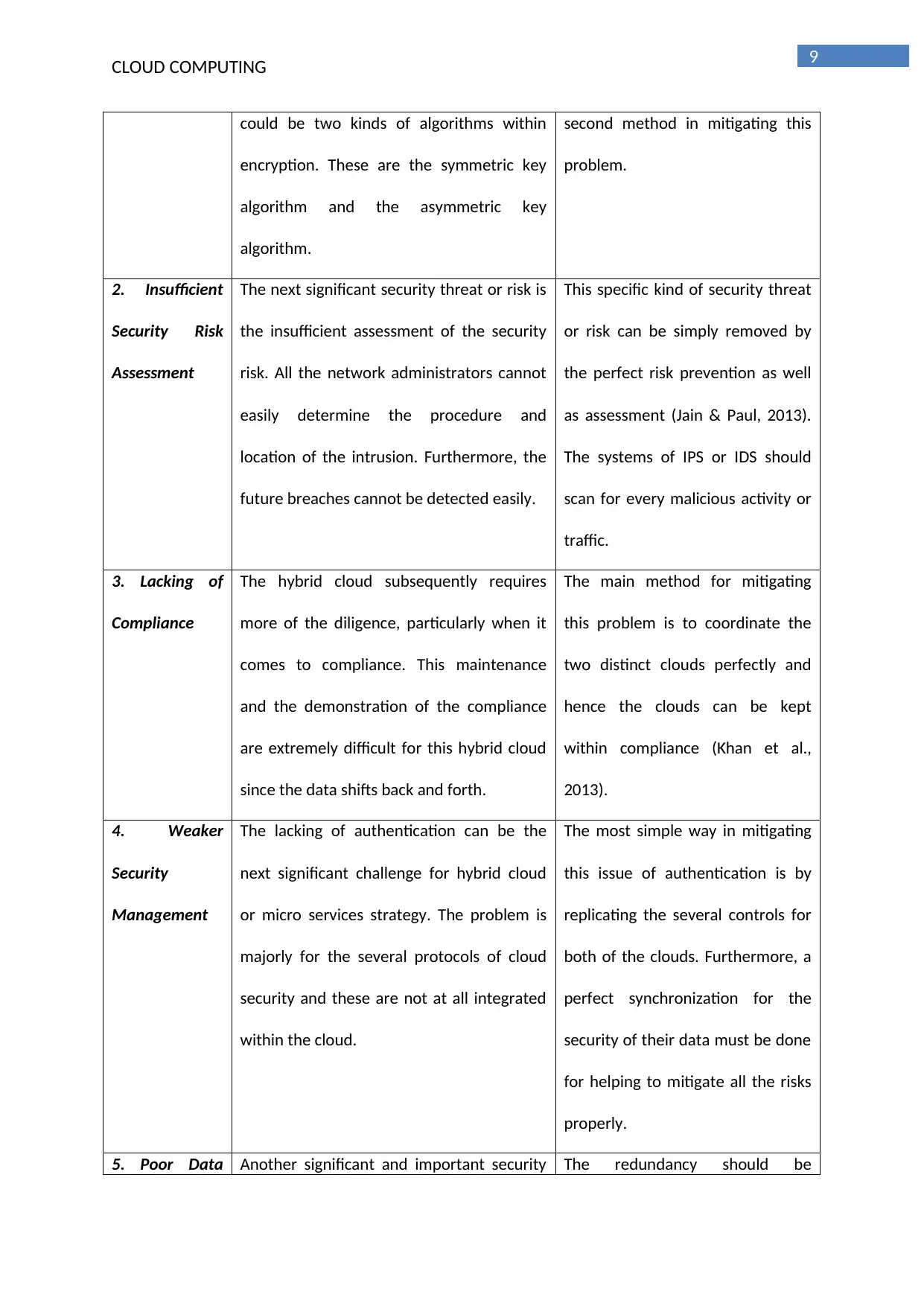
9
CLOUD COMPUTING
could be two kinds of algorithms within
encryption. These are the symmetric key
algorithm and the asymmetric key
algorithm.
second method in mitigating this
problem.
2. Insufficient
Security Risk
Assessment
The next significant security threat or risk is
the insufficient assessment of the security
risk. All the network administrators cannot
easily determine the procedure and
location of the intrusion. Furthermore, the
future breaches cannot be detected easily.
This specific kind of security threat
or risk can be simply removed by
the perfect risk prevention as well
as assessment (Jain & Paul, 2013).
The systems of IPS or IDS should
scan for every malicious activity or
traffic.
3. Lacking of
Compliance
The hybrid cloud subsequently requires
more of the diligence, particularly when it
comes to compliance. This maintenance
and the demonstration of the compliance
are extremely difficult for this hybrid cloud
since the data shifts back and forth.
The main method for mitigating
this problem is to coordinate the
two distinct clouds perfectly and
hence the clouds can be kept
within compliance (Khan et al.,
2013).
4. Weaker
Security
Management
The lacking of authentication can be the
next significant challenge for hybrid cloud
or micro services strategy. The problem is
majorly for the several protocols of cloud
security and these are not at all integrated
within the cloud.
The most simple way in mitigating
this issue of authentication is by
replicating the several controls for
both of the clouds. Furthermore, a
perfect synchronization for the
security of their data must be done
for helping to mitigate all the risks
properly.
5. Poor Data Another significant and important security The redundancy should be
CLOUD COMPUTING
could be two kinds of algorithms within
encryption. These are the symmetric key
algorithm and the asymmetric key
algorithm.
second method in mitigating this
problem.
2. Insufficient
Security Risk
Assessment
The next significant security threat or risk is
the insufficient assessment of the security
risk. All the network administrators cannot
easily determine the procedure and
location of the intrusion. Furthermore, the
future breaches cannot be detected easily.
This specific kind of security threat
or risk can be simply removed by
the perfect risk prevention as well
as assessment (Jain & Paul, 2013).
The systems of IPS or IDS should
scan for every malicious activity or
traffic.
3. Lacking of
Compliance
The hybrid cloud subsequently requires
more of the diligence, particularly when it
comes to compliance. This maintenance
and the demonstration of the compliance
are extremely difficult for this hybrid cloud
since the data shifts back and forth.
The main method for mitigating
this problem is to coordinate the
two distinct clouds perfectly and
hence the clouds can be kept
within compliance (Khan et al.,
2013).
4. Weaker
Security
Management
The lacking of authentication can be the
next significant challenge for hybrid cloud
or micro services strategy. The problem is
majorly for the several protocols of cloud
security and these are not at all integrated
within the cloud.
The most simple way in mitigating
this issue of authentication is by
replicating the several controls for
both of the clouds. Furthermore, a
perfect synchronization for the
security of their data must be done
for helping to mitigate all the risks
properly.
5. Poor Data Another significant and important security The redundancy should be
Paraphrase This Document
Need a fresh take? Get an instant paraphrase of this document with our AI Paraphraser
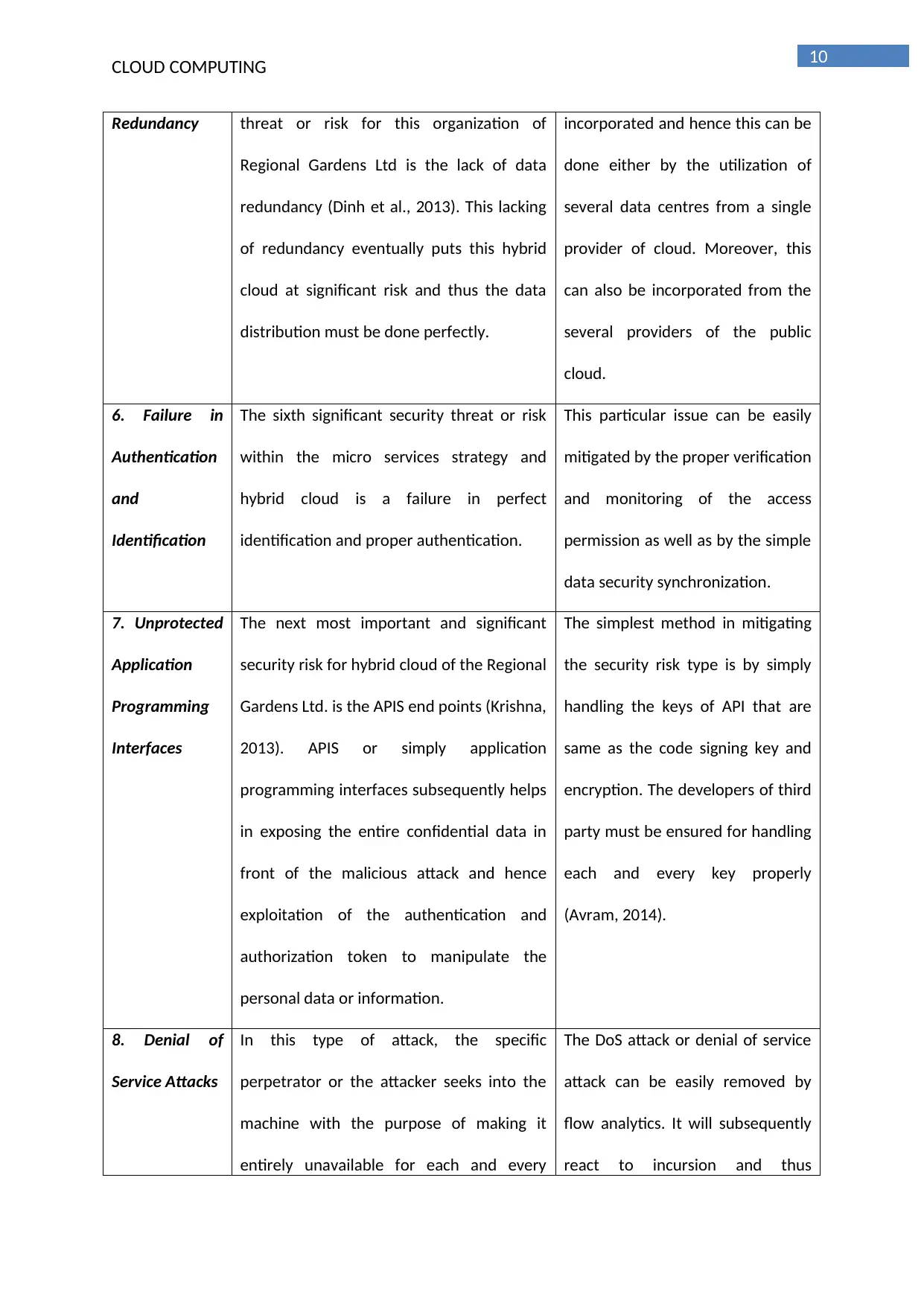
10
CLOUD COMPUTING
Redundancy threat or risk for this organization of
Regional Gardens Ltd is the lack of data
redundancy (Dinh et al., 2013). This lacking
of redundancy eventually puts this hybrid
cloud at significant risk and thus the data
distribution must be done perfectly.
incorporated and hence this can be
done either by the utilization of
several data centres from a single
provider of cloud. Moreover, this
can also be incorporated from the
several providers of the public
cloud.
6. Failure in
Authentication
and
Identification
The sixth significant security threat or risk
within the micro services strategy and
hybrid cloud is a failure in perfect
identification and proper authentication.
This particular issue can be easily
mitigated by the proper verification
and monitoring of the access
permission as well as by the simple
data security synchronization.
7. Unprotected
Application
Programming
Interfaces
The next most important and significant
security risk for hybrid cloud of the Regional
Gardens Ltd. is the APIS end points (Krishna,
2013). APIS or simply application
programming interfaces subsequently helps
in exposing the entire confidential data in
front of the malicious attack and hence
exploitation of the authentication and
authorization token to manipulate the
personal data or information.
The simplest method in mitigating
the security risk type is by simply
handling the keys of API that are
same as the code signing key and
encryption. The developers of third
party must be ensured for handling
each and every key properly
(Avram, 2014).
8. Denial of
Service Attacks
In this type of attack, the specific
perpetrator or the attacker seeks into the
machine with the purpose of making it
entirely unavailable for each and every
The DoS attack or denial of service
attack can be easily removed by
flow analytics. It will subsequently
react to incursion and thus
CLOUD COMPUTING
Redundancy threat or risk for this organization of
Regional Gardens Ltd is the lack of data
redundancy (Dinh et al., 2013). This lacking
of redundancy eventually puts this hybrid
cloud at significant risk and thus the data
distribution must be done perfectly.
incorporated and hence this can be
done either by the utilization of
several data centres from a single
provider of cloud. Moreover, this
can also be incorporated from the
several providers of the public
cloud.
6. Failure in
Authentication
and
Identification
The sixth significant security threat or risk
within the micro services strategy and
hybrid cloud is a failure in perfect
identification and proper authentication.
This particular issue can be easily
mitigated by the proper verification
and monitoring of the access
permission as well as by the simple
data security synchronization.
7. Unprotected
Application
Programming
Interfaces
The next most important and significant
security risk for hybrid cloud of the Regional
Gardens Ltd. is the APIS end points (Krishna,
2013). APIS or simply application
programming interfaces subsequently helps
in exposing the entire confidential data in
front of the malicious attack and hence
exploitation of the authentication and
authorization token to manipulate the
personal data or information.
The simplest method in mitigating
the security risk type is by simply
handling the keys of API that are
same as the code signing key and
encryption. The developers of third
party must be ensured for handling
each and every key properly
(Avram, 2014).
8. Denial of
Service Attacks
In this type of attack, the specific
perpetrator or the attacker seeks into the
machine with the purpose of making it
entirely unavailable for each and every
The DoS attack or denial of service
attack can be easily removed by
flow analytics. It will subsequently
react to incursion and thus
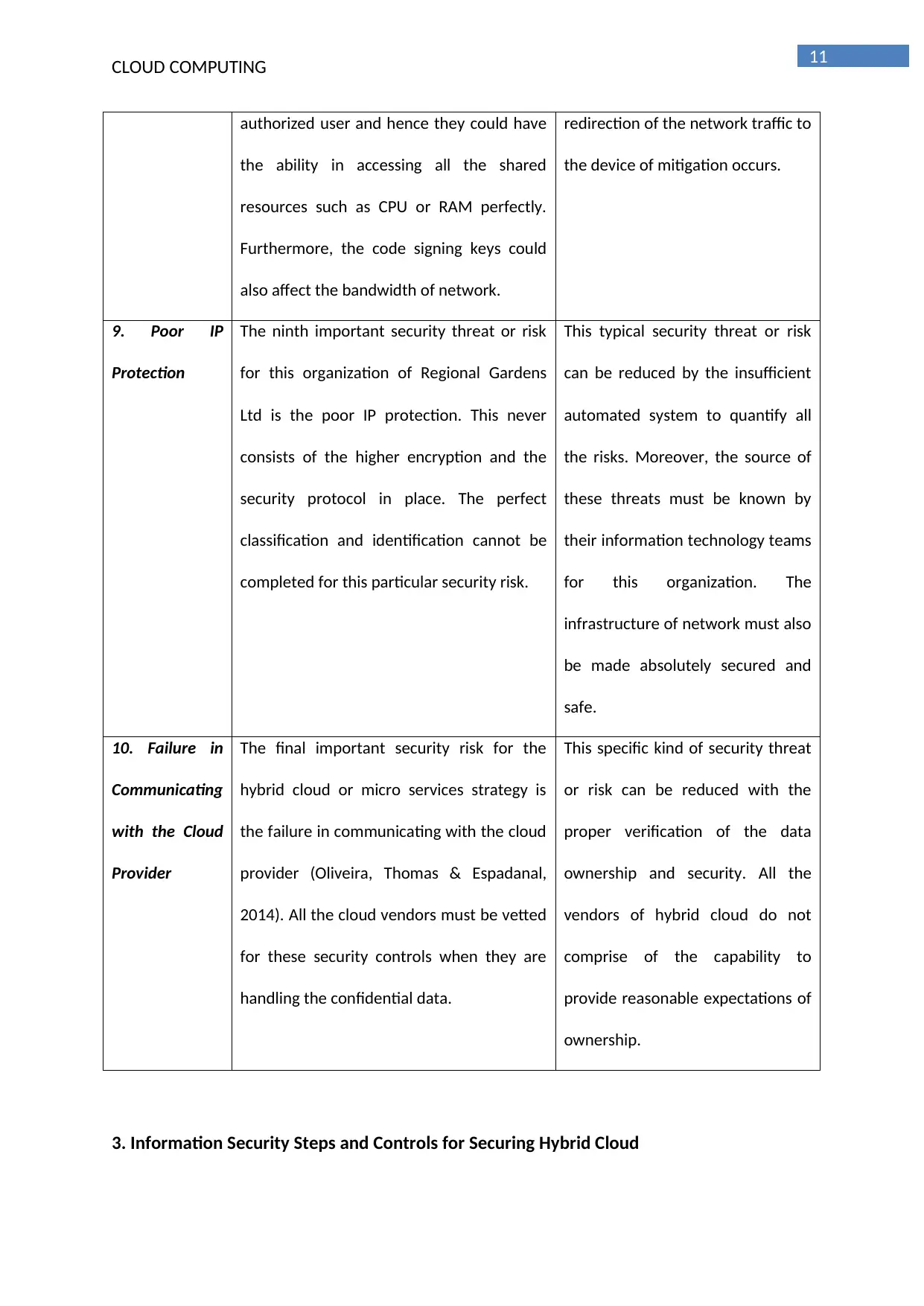
11
CLOUD COMPUTING
authorized user and hence they could have
the ability in accessing all the shared
resources such as CPU or RAM perfectly.
Furthermore, the code signing keys could
also affect the bandwidth of network.
redirection of the network traffic to
the device of mitigation occurs.
9. Poor IP
Protection
The ninth important security threat or risk
for this organization of Regional Gardens
Ltd is the poor IP protection. This never
consists of the higher encryption and the
security protocol in place. The perfect
classification and identification cannot be
completed for this particular security risk.
This typical security threat or risk
can be reduced by the insufficient
automated system to quantify all
the risks. Moreover, the source of
these threats must be known by
their information technology teams
for this organization. The
infrastructure of network must also
be made absolutely secured and
safe.
10. Failure in
Communicating
with the Cloud
Provider
The final important security risk for the
hybrid cloud or micro services strategy is
the failure in communicating with the cloud
provider (Oliveira, Thomas & Espadanal,
2014). All the cloud vendors must be vetted
for these security controls when they are
handling the confidential data.
This specific kind of security threat
or risk can be reduced with the
proper verification of the data
ownership and security. All the
vendors of hybrid cloud do not
comprise of the capability to
provide reasonable expectations of
ownership.
3. Information Security Steps and Controls for Securing Hybrid Cloud
CLOUD COMPUTING
authorized user and hence they could have
the ability in accessing all the shared
resources such as CPU or RAM perfectly.
Furthermore, the code signing keys could
also affect the bandwidth of network.
redirection of the network traffic to
the device of mitigation occurs.
9. Poor IP
Protection
The ninth important security threat or risk
for this organization of Regional Gardens
Ltd is the poor IP protection. This never
consists of the higher encryption and the
security protocol in place. The perfect
classification and identification cannot be
completed for this particular security risk.
This typical security threat or risk
can be reduced by the insufficient
automated system to quantify all
the risks. Moreover, the source of
these threats must be known by
their information technology teams
for this organization. The
infrastructure of network must also
be made absolutely secured and
safe.
10. Failure in
Communicating
with the Cloud
Provider
The final important security risk for the
hybrid cloud or micro services strategy is
the failure in communicating with the cloud
provider (Oliveira, Thomas & Espadanal,
2014). All the cloud vendors must be vetted
for these security controls when they are
handling the confidential data.
This specific kind of security threat
or risk can be reduced with the
proper verification of the data
ownership and security. All the
vendors of hybrid cloud do not
comprise of the capability to
provide reasonable expectations of
ownership.
3. Information Security Steps and Controls for Securing Hybrid Cloud
⊘ This is a preview!⊘
Do you want full access?
Subscribe today to unlock all pages.

Trusted by 1+ million students worldwide
1 out of 26
Related Documents
Your All-in-One AI-Powered Toolkit for Academic Success.
+13062052269
info@desklib.com
Available 24*7 on WhatsApp / Email
![[object Object]](/_next/static/media/star-bottom.7253800d.svg)
Unlock your academic potential
Copyright © 2020–2025 A2Z Services. All Rights Reserved. Developed and managed by ZUCOL.





